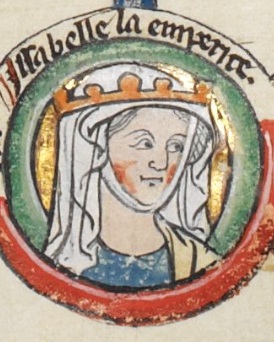
Isabella of England
Isabella of England (1214 – 1 December 1241) was an English princess of the House of Plantagenet. She became Holy Roman Empress, Queen of Sicily, Italy and Germany from 1235 until her death as the third wife of Emperor Frederick II.
For the daughter of Edward III of England, see Isabella, Countess of Bedford.Isabella of England
15 July 1235 – 1 December 1241
1 December 1241 (aged 26–27)
Foggia, Kingdom of Sicily
Life[edit]
Birth and early years[edit]
Isabella was born around 1214 as the fourth child and second daughter of John, King of England and his second wife Isabella of Angoulême.[1][2][3] Her exact date of birth is unknown, and the year is calculated based on the fact that Matthew Paris reported that the princess got married at the age of 21.[4] By the time Isabella was born, her parents' marriage had already started to unravel, and the princess spent most of the time with her mother. After the death of King John in 1216, Isabella remained in the full care of her mother and was with her until 1220, when Isabella of Angouleme remarried and left the English court.[5]
The princess was raised from an early age by the "nurse and governess" Margaret Biset, who received for her services from 1219, by order of her brother King Henry III, one penny a day[2] "from the hands of the Viscount Hereford";[6] she remained within Isabella's household and accompanied her to Germany sixteen years later, when the princess married.[2] The services of the rest of the princess's servants (cook, stableman and others) were also paid by her brother, and by his order, when some of Isabella's servants retired from her service, they were assigned a generous pension.[7] The first years of Isabella's life were spent in Gloucester Castle. Later, when the problems that accompanied the early years of her brother's reign ended, she was transported to the court, at first located at Woodstock Palace in Oxfordshire and later at Westminster. From time to time, the princess with her family visited other royal residences: Winchester, Marlborough, Northampton, York and others.[6]
Youth[edit]
In June 1220[7] or 1221 Isabella's older sister, Joan, was betrothed to King Alexander II of Scotland, and according to the marriage contract, if Joan did not have time to return to England by Michael's Day (29 September),[a] within two weeks after that, the Scottish King was to marry Isabella. Twice over the next ten years, King Henry III tried to marry off his sister (probably Isabella[b]):[2] first, in 1225, were negotiations for a marriage with King Henry (VII) of Germany (who ten years later became Isabella's stepson)[8][c] and then to King Louis IX of France.[2]
Once the princess got older, the more she loved privacy. In November 1229, with the permission of her brother, she departed for Marlborough Castle, which became her residence; at this time, reconstruction was being completed in the castle, and King Henry III ordered the constable of the castle to allow his sister to choose any quarters she wanted. The relationship between brother and sister was very warm, and the King visited Isabella several times: he visited Marlborough during the celebration of the wedding of "the maiden Catherine" who served Isabella, and also visited his sister in 1231 and 1232 at Gloucester Castle. On 13 November 1232, King Henry III sent his personal tailor to his sister to make her a new full wardrobe.[10] The King also celebrated Christmas with Isabella that year; he sent her three of the best dishes from his table and presented many gifts, and then for several months he sent her the items needed to equip the princess's own chapel. Provisions for Isabella and her guests were provided by "two or three worthy men" from Gloucester, while wine and venison were regularly sent to his sister by the King, who also provided one of his fish suppliers for use by Isabella. The royal chaplain, Warin, who served Isabella, was also granted to his sister by the King. In the summer of 1232, Isabella returned to Marlborough Castle.[11]
Sources are at variance concerning Isabella's issue, including the number of children she had, their names, and their birth order: